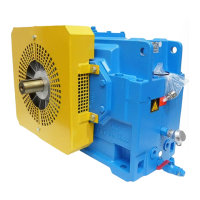67 / 109
BA 5846 en 05/2015
The coupling parts may get out of alignment:
─ through imprecise alignment during assembly or installation
,
─ during operation of the system
─ through heat expansion,
─ through shaft flexure,
─ through too weak machine frames, etc.
ΔKa
ΔKw
ΔKr
Axial misalignment
(ΔKa)
Angular misalignment
(ΔKw)
Radial misalignment
(ΔKr)
Fig. 37: Possible misalignments
Alignment has to be done in two axial planes situated perpendicularly to each other. This can be done by
means of a ruler (radial misalignment) and feeler gauge (angular misalignment), as shown in the
illustration. The aligning accuracy can be increased by using a dial gauge or a laser alignment system.
3
3
3
3
1
2
Fig. 38: Example of alignment on a flexible coupling
1 Ruler
2 Feeler gauge
3 Measuring points
NOTICE
Material damage
Risk of damage to or destruction of the coupling through incorrect alignment.
The maximum permissible misalignment values are specified in the operating instructions for the
coupling; they must under no circumstances be exceeded during operation.
Angular and radial misalignments may occur at the same time. The sum of both misalignments must not
exceed the maximum permissible value of the angular or radial misalignment.
If you use couplings manufactured by other manufacturers, ask these manufacturers which alignment
errors are permissible, stating the radial loads occurring.
Note
For alignment of the drive components (vertical direction), it is recommended to use packing or foil plates
underneath the mounting feet. The use of claws with set screws on the foundation for lateral adjustment
of the drive components is also advantageous.

